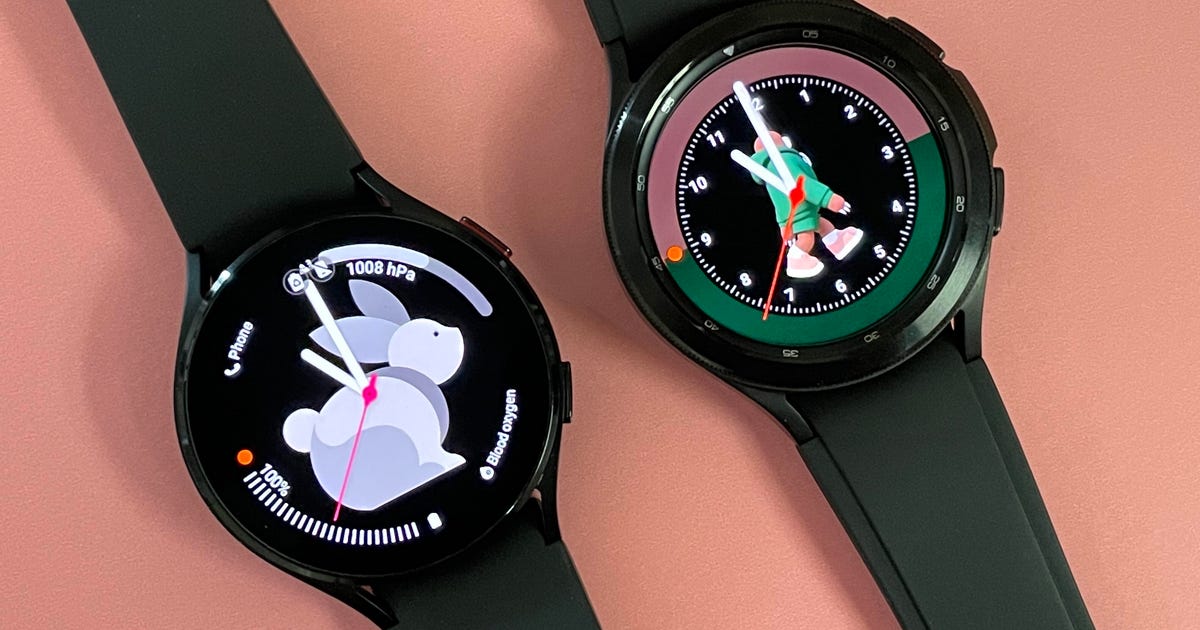
Samsung Galaxy Watch 4 review: The obedient take of a great future idea
I’d love to say the new Samsung Galaxy Watch 4, which starts at $250 (£249), delivers the ultimate Android ogle experience. I can’t quite say that, but it’s terminate. After wearing Samsung’s newest watches for two weeks, nonetheless, I’ve liked it more over time. It’s the obedient to run a whole new Google Wear OS co-designed by Samsung and Google, and while I’d say the future looks promising, the narrate looks a little unresolved. In a sense, my remaining feelings now are still pretty similar to my first few days wearing them.
Samsung invents great watches. The Galaxy Watch 3 was a transparent mix of fitness and health features and a lot of smartwatch connectivity. But Samsung’s Tizen OS and app store always stayed apart from Google’s Android ecosystem. The Galaxy Watch 4 has much of the same build and features as last year’s watch, but with more health sensor tech. The OS is the Big New Thing, though.
Moving to Google’s Wear OS, a smartwatch platform that’s been throughout for years, means the Watch 4 runs Google Play apps and can theoretically be a lot more hooked-in to Android phones. I say “theoretically” because, right now, a lot of the key things on the Galaxy Watch 4 remained to run off Samsung apps, which require a Samsung define. It’s part of the Google ecosystem, but also stands apart from it.
The Galaxy Watch 4 can run Google Fit and latest fitness apps, but Samsung Health is the only keep where health features like ECG (electrocardiogram) and a new bioelectric impedance sensor for body analysis measurements can be synced. Some health features, like ECG (and blood pressure in some countries) need a Samsung requested to work, too.
Google Assistant, arguably the most important Google feature you’d want on a voice-connected smartwatch, is also a no-show for now. Samsung’s Bixby is the default.
It all adds up to a Samsung ogle that feels more like a lateral move after last year’s Watch 3 than a whole leap up. While moving to Wear OS is a big deal, and could mean this ogle finally feels as integrated to Android phones as Apple Watches do to iPhones, it feels like the Samsung ecosystem Band-Aid hasn’t been ripped off completely. Based on how Samsung’s Galaxy phones run Samsung apps vivid next to Google apps, that may not ever be probable to change. And that makes this first Samsung-Google ogle collaboration a tiny bit hard to recommend since I don’t know what future Wear OS watches could be like. Is Samsung’s version the best? honest now, yes, because I can’t think of any Android ogle that’s as well-made and full-featured as the Watch 4. But remember, again, you’re really best off using this with a Samsung phone.
Google and Samsung: Together anti (sometimes)
The new Wear OS-based operating system on the Watch 4 is the biggest spiteful this time. The Galaxy Watch is Android-only, a goes from previous Galaxy and Wear watches that could also connect in a microscopic way to iPhones. The Wear OS experience feels a lot like spanking Android watches: swiping down for quick-access settings, up for an app tray, knowing for notifications, and left for “tiles,” which are like mini-app readouts.
The tile understood carries over from previous Samsung watches: fitness dashboards can be browsed, the weather checked, text messages scanned. It’s best used, for me, as a way to get to fitness functions fast. I can rotate the bezel or swipe a combine of times to start a workout, or get a body analysis, check blood oxygen, get an ECG scan.
Google Play is the only app continue on the Galaxy Watch 4, so it hooks into existing Google apps like Fit, YouTube, and Maps. But the rest of the setup treat feels very Samsung. You’re using a Samsung Wear app to pair the notice, and Samsung Health as the go-to fitness/health app.
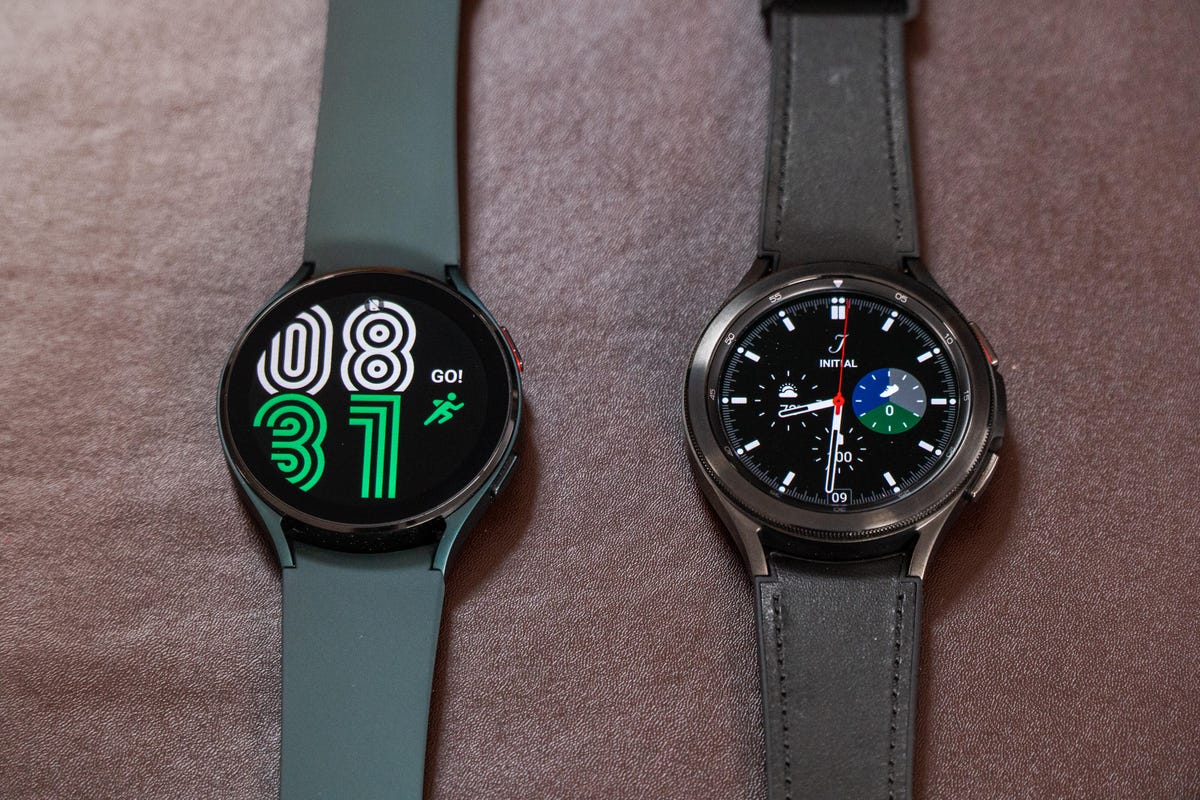
The Galaxy Watch 4 (left) next to the Watch 4 Classic (right). Note the bezel around the rim.
Drew Evans
Design: The bezel’s back
Samsung’s always made watches that feel good on the wrist, and the lighter-weight Galaxy Watch 4 is great to wear, for the most part. I tried both the larger 44mm Galaxy Watch 4 (aluminum body) and the 46mm Galaxy Watch 4 Classic (stainless steel). The Classic adds the physical rotating bezel that clicks, the same as the Watch 3 and previous Samsung watches, while the Watch 4 relies on dragging your finger near the display edge to for a touch-based “spin” like the Galaxy Watch Active and Active 2 (with some haptics-based feedback for “click”).
The Classic’s recessed Gorilla Glass prove protects it from impact, but also makes pulling off some of the watch’s swipe-based interactions a bit harder thanks to that bezel. Also, it’s thicker and more expensive. I’m torn between Classic and the unique Watch 4, truly. I lean towards the basic Watch 4 because it does the same things more affordably and unexcited looks good, but the more exposed glass could end up scuffing more over time. And the touch-based bezel is harder to turn than spinning a brute bezel, even if it’s a largely unnecessary action (you can do all gestures you need above swipes and taps on the display, or by clicking the side buttons). Also, if you’re a swimmer, that physical bezel complains the watch easier to operate when wet.
I didn’t look at the smaller Watch 4, but both bigger sizes seemed great on my large wrists. The 20mm pin-release notice straps can be replaced with other bands, more like a heinous watch strap than anything proprietary. The straps bulge out a bit from the lugs, view, making the fit look a little stiff on-wrist.
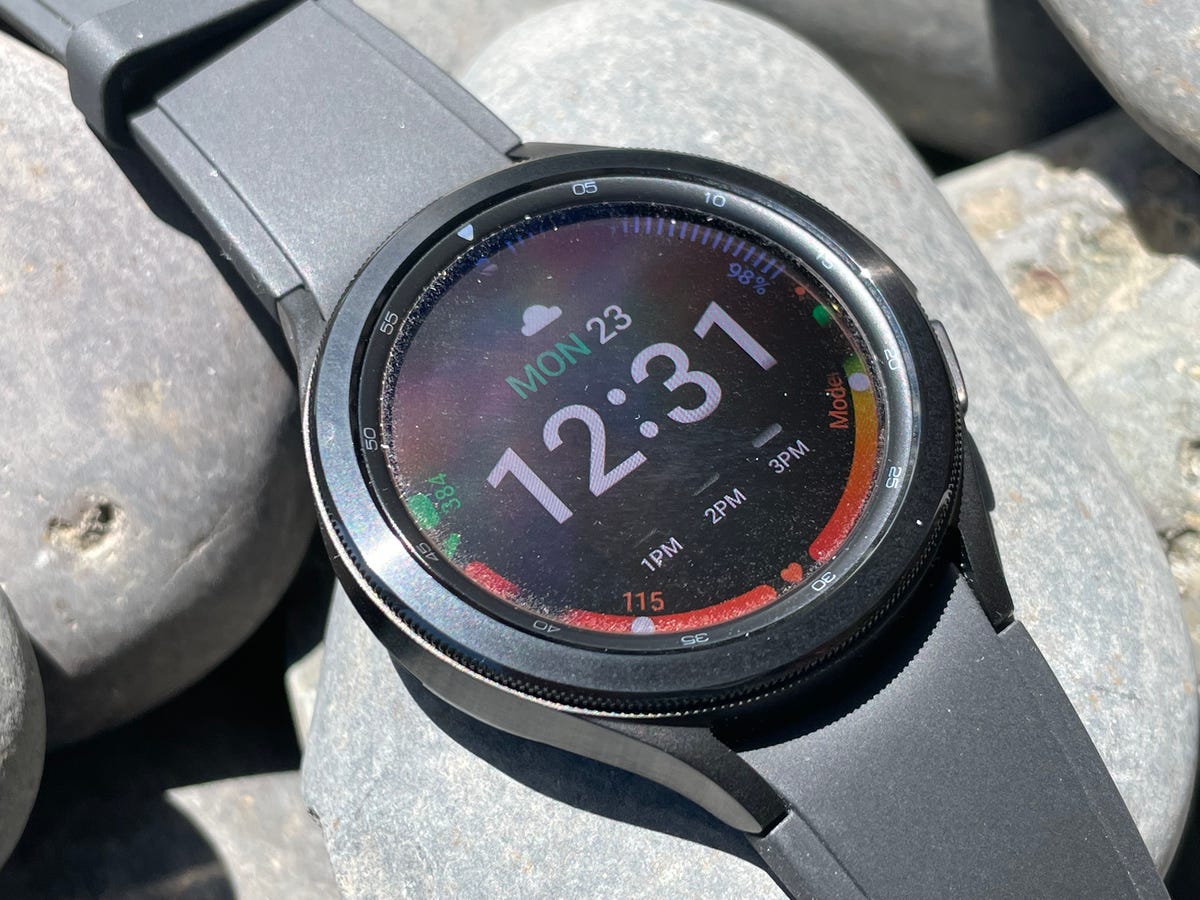
Dust and all, a look at how the prove fares in bright sunlight. (Really well.)
Scott Stein
The Super AMOLED prove looks great, bright and crisp and colorful. Samsung’s preloaded notice faces are also really lovely. The animated animals, cute characters, and frequently dynamic effects make this watch’s faces feel like the best ones I’ve seen outside of the Apple Watch. Most have lots spaces for complications (widgets for apps to show data, like atmosphere or fitness info). Others have none. Google’s own Wear OS notice faces are available too, along with plenty on Google Play to check out.
The redesigned sensor array on the back of the Watch 4 looks arresting, and combines the electrical ECG sensor from previous watches, plus optical heart rate and a new impedance-based electrical sensor. It’s pretty to look at. It also feels less chunky than previous watches did.
Two side buttons bring up Samsung Pay (or Google Pay) when long-pressed, and Samsung Bixby for voice assistant stuff. Yes, Bixby. More on that below. The buttons can be single-pressed or double-pressed for spanking home/back navigation, and can be assigned a few spanking limited actions in the Samsung Wear app that’s obliged to pair the watches to your phone.
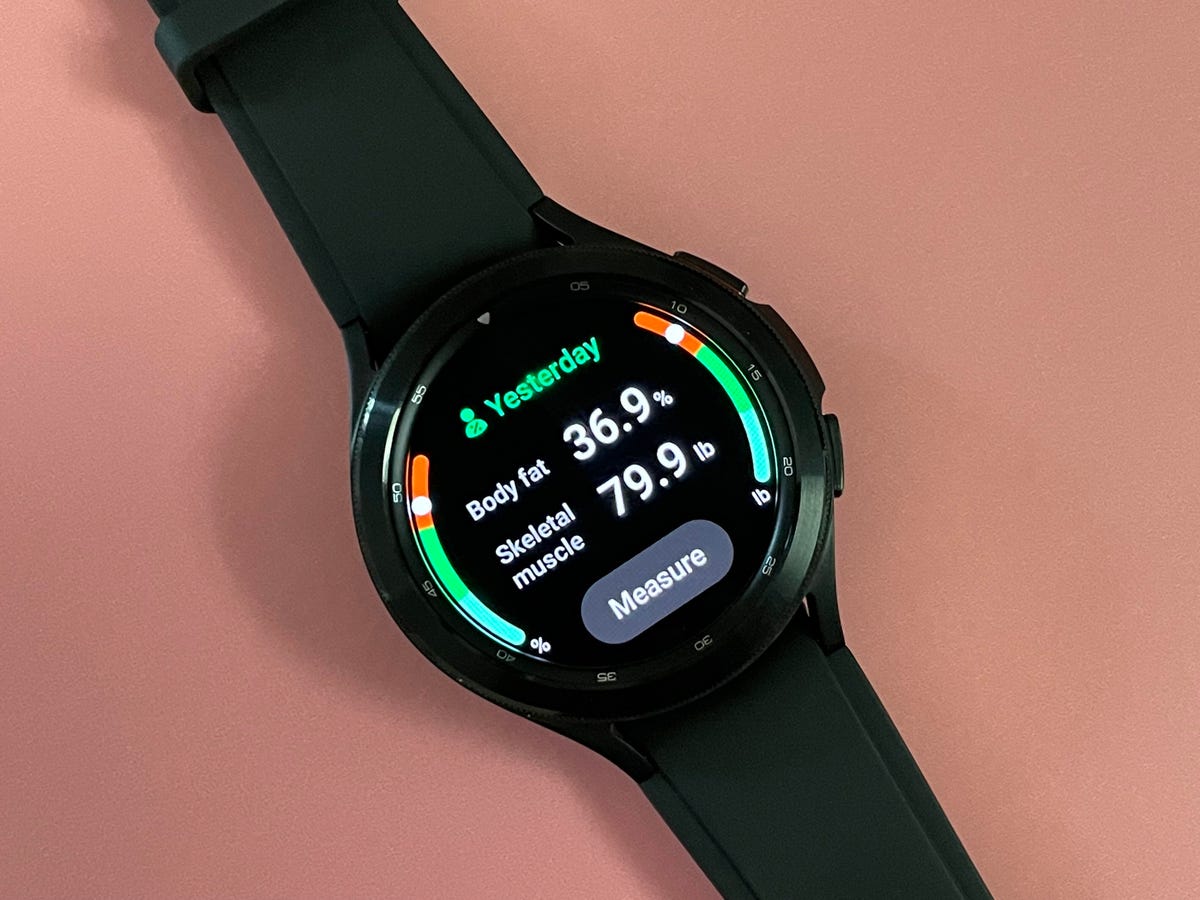
I’m totally embarrassed by my body analysis readings via electrical impedance on Samsung’s newest sensor.
Scott Stein
Body Analysis: A feature in notice of a good use case
Samsung’s newest health sensor on the Watch 4 is electrical impedance, a sensor technology that’s found on some home scales, and even popped up on early wearables like the Jawbone Up 3. The impedance sensor uses electrical current to estimate body stream content, which is used to calculate body fat percentage, skeletal muscle mass, and body water. The app asks for your daily weight, then after a 15-second scan (which is done by holding your middle two fingers anti the watch buttons while staying still), it spits out a readout of BMI, muscle mass, body fat and stream mass.
These readouts are a lot to deal with. Mine were all bad (in the red part of a green-to-red scale), along with numbers (like pounds of body fat or body stream, or skeletal muscle). How bad were these numbers? Should I freak out? Samsung takes the data and imports it into the Samsung Health app, and charts the results over time. I can see my goes (or stasis), and…what then? Samsung doesn’t really help define what it all means, or how concerned I necessity be. What workouts should I do next?
New sensors are always a challenge like this. After all, blood oxygen readings (which aren’t medically accurate) were all the rage with Apple, Samsung and Fitbit last year, and I found that I basically started ignoring the data. Fitbit’s electrical-based EDA wound sensor on its Sense watch last year showed possible signs of wound in spot-check scans, but I never found myself comical it much and never knew what to make of those results, either. Samsung’s body analysis tool feels intimidating and, for me, discouraging. I started to avoid it, because I already know I’m way too overweight.
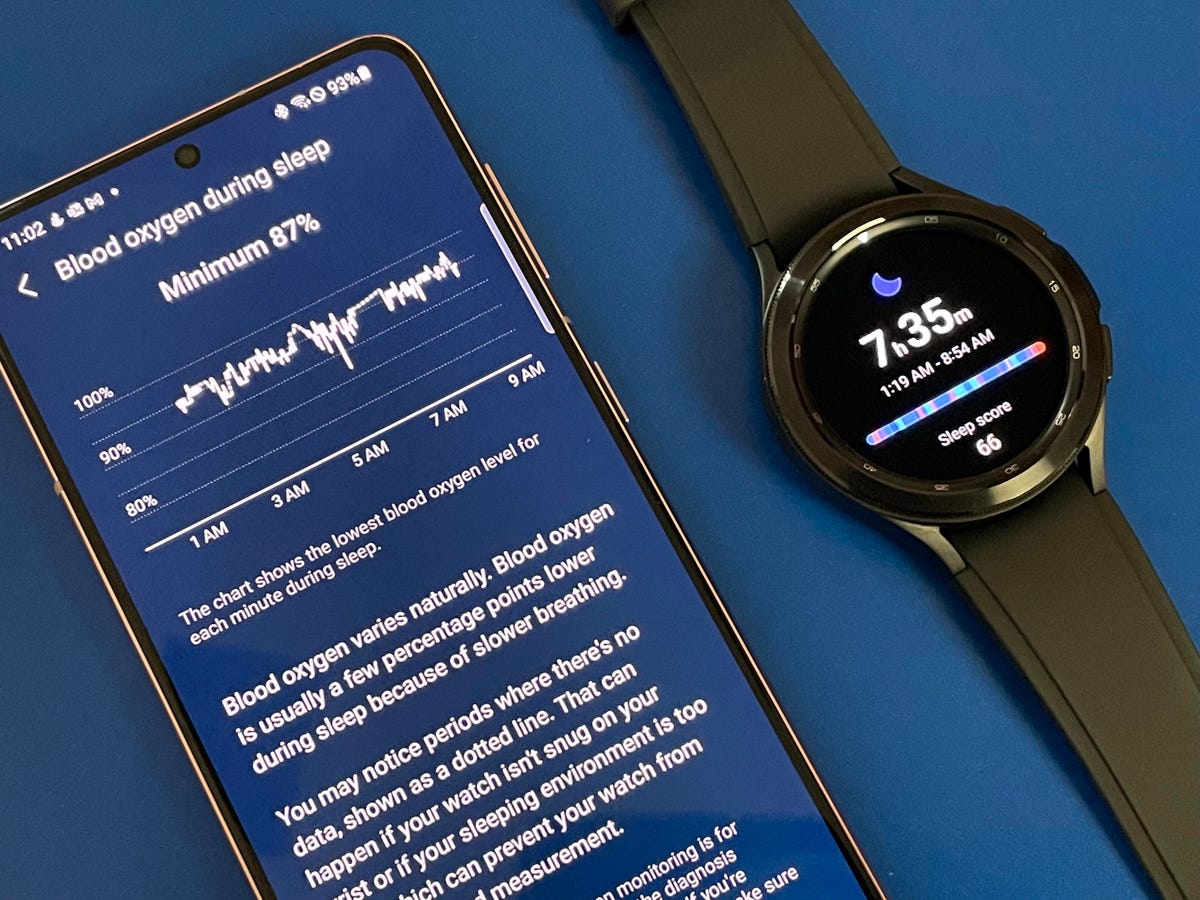
Blood oxygen measurements existed overnight… not always sure what to make of this either (the continuous readings aren’t necessarily moral, either).
Scott Stein
Health: A Samsung earth that expects a Samsung phone
Most people I know who wear smartwatches use them for fitness, to at least some degree. Samsung knows this, and has a core focus on fitness and health on its watches. But that world is still Samsung app-based.
Samsung Health isn’t bad at all. In fact, it’s got tons of features: sleep tracking and sleep derive (which isn’t medically accurate, same as all sleep tracking on wearables, but can do a decent job overnight with sensing how well you were sleeping). Running, and run analysis. Blood oxygen. Food and soak tracking. Steps, activity goals. Team activity sharing challenges. That new body analysis data.
I really appreciated the watch’s sleep tracking (much like Fitbit, the sleep score kept me somewhat aware of how bad my sleep habits are, and encouraged me to go to bed earlier). The automatic activity tracking, which kicks into a view face with a live heart rate readout, is astronomical for brisk walks and spontaneous workouts. It’s a really solid package.

The rear sensor is redesigned, combining ECG, impedance and optical heart rate. It looks sharp.
Drew Evans
But Google has its own pair of fitness-tracking apps: Google Fit, and the recently settled Fitbit. Google Fit apps can be loaded onto the Watch 4 for tracking in contradiction of Samsung Health, but Samsung still expects your data to flow throughout Samsung Health as well. Fitbit doesn’t have any Wear OS apps yet, but is anticipated to have some later this year…even so, there won’t be a chance of having Fitbit’s full tracking capabilities managing on this watch anytime soon.
And there’s another wrinkle: you need to pair this view with a Samsung phone to use the health features that have moral medical clearance. Why? I have no idea. The separate Samsung Health Monitor app that collects data from ECG and blood pressure readings is only available on Samsung’s Galaxy App Store luminous now, which means other Android phones can’t access it. It’s bizarre, since ECG wearables like Fitbit Sense just pair with normal Google Play apps.
An ECG is an electrical test for dejected arrhythmia, similar to what’s on the Apple Watch Series 4 and later, or the Fitbit Sense. It’s FDA-cleared, but doesn’t detect dejected attacks or other heart disease, and isn’t a replacement for seeing a cardiologist. Meanwhile, Samsung has a blood pressure feature that uses the optical dejected rate monitor to get readings, once the watch has been calibrated comical a physical blood pressure cuff. That blood pressure feature collected isn’t cleared for use in the US yet, and in anunexperienced areas of the world you’ll still need a Samsung arranged to use the Health Monitor app.
Google Assistant: MIA. Hi, Bixby
As I said earlier: Google’s helpful voice-based Assistant isn’t on the Galaxy Watch 4. Instead, you’re stuck with Bixby as the only assistant for now. That’s incredibly frustrating considering how good Google Assistant is, and how Samsung’s Google Wear OS partnership gazed to be lining up specifically to allow things like Assistant. Google Assistant should be coming sometime, I think, but it’s unclear. It’s hard to promise what isn’t there.

Bixby works well for snarl responses! Seriously.
Scott Stein
Bixby does some useful things: it can run voice dictation well enough to respond to notifications on Slack when I get a meaning midday. It can set timers and handle basic functions. But it won’t hook into the rest of Google. Without Assistant, this watch doesn’t really feel very Google-like at all.

The Galaxy Watch 4’s snap-on magnetic charger. You’ll need it every couple of days.
Scott Stein
Performance: Fast. Battery life: Two days (or less)
The Galaxy Watch 4 feels very fast, and loads apps faster than any Android view I can remember. It’s not always as lightning-quick as the unexperienced Apple Watch, but it still feels great. The watch’s new chipset seems to be a very good sign of where anunexperienced Google watches could go as far as feeling more responsive.
Battery life? Not as mountainous, alas. I swapped the Watch 4 and Watch 4 Classic on my wrist for weeks, putting one on when the other ran out of batteries, sleeping with the watch overnight. Battery life never was better than two days. And that’s with the always-on explore face turned off. When it’s on, I only got throughout a day of use before needing a charge. And the smaller explore may have even shorter battery life. Also, if you get an LTE-equipped model that doubles as a phoned (which I didn’t get to test and costs extra), expect battery life to be even less. Same with silly the watch for GPS-enabled workouts.
Charging is reasonably fast, though: About half an hour gave me enough top-off battery to wear for the rest of the day if needed.
My impressions for now: Promisingly incomplete
Here’s the real quiz looming over the Watch 4: it’s the first of a new line of Google Wear OS-enabled watches coming down the road. Others may not get the new OS until 2022: Fossil’s next watches, Mobvoi’s newer TicWatch models, and a promised Fitbit Wear OS watch.
Samsung is leading the pack with the edifying effort, and the Galaxy Watch 4 has a lot repositioning for it. But it still doesn’t feel like One Unified OS to make me feel like I’m solidly in one ecosystem. That’s because I’m not: it’s still Samsung’s watch humankind, with a Google layer underneath.
Maybe that was the idea all consume. Maybe the watch will get even better over time. But will the next Wear OS watches be incompatibility, or even better? I can’t tell. Samsung’s Galaxy Watch 4 may be the best option for now, and it doesn’t feel as fully perfected as I expected.
It may not be the ultimate Android explore, but it’s the best Android watch for now.
Samsung Galaxy Watch 4 review: The first take of a great future idea. There are any Samsung Galaxy Watch 4 review: The first take of a great future idea in here.
About Me
Total Pageviews
Search This Blog
Blog Archive
-
-
-
-
- GM boss Mary Barra says it can beat Tesla in EV sa...
- Instagram reveals Bolt, a Snapchat-like messaging app
- Galaxy Watch 4: Samsung is coming for Apple Watch'...
- Samsung Galaxy S Aviator (U.S. Cellular) review: S...
- 2023 Genesis GV60 Electric SUV Price and Availabil...
- New and Rumored AT&T Phones in 2022: iPhone SE, Ga...
- Tesla recalls new Model S, Model X EVs for airbags...
- Amazfit Bip S smartwatch review: Price and battery...
- Samsung shows off new Galaxy S22 phones and Galaxy...
- GPU Stock Begins to Normalize With Price Cuts on t...
- Galaxy Z Flip vs. Motorola Razr vs. Galaxy Fold: F...
- Potentially massive Tesla Full Self-Driving rollou...
- Snapchat test lets you point camera at products an...
- Apple Watch SE's Rumored Update Could Be the Most ...
- Samsung may release future Galaxy S phones with cu...
- MacBook Air M2: We Tried Out Apple's New Laptop
- Samsung drops Galaxy Z Fold 2 price by $200, launc...
- Tesla recalls 12,000 EVs affected by Full Self-Dri...
- Ditch Your Apple Watch Series 3 and Grab a Series ...
- S21 Plus vs. Note 20 Ultra: Which Samsung flagship...
- Rivian Hits Reverse on Price Hikes for Existing Re...
- Samsung's Galaxy Z Fold 2 will fit in your pocket ...
- Tesla recalls some Model 3, Model Y EVs for suspen...
- Snapchat Spectacles are so LA
- Samsung to overhaul smartwatch with Galaxy Watch 4...
- 'Doctor Strange and the Multiverse of Madness' Rev...
- Samsung Galaxy Z Fold 3: Can the upgrades win over...
- What Is Shrinkflation and What Does It Mean for Yo...
- The Webb Space Telescope Might Have Already Smashe...
- Tesla Autopilot under federal investigation for cr...
- FDA clears ScanWatch, a hybrid smartwatch that mon...
- Best Camera to Buy In 2022
- 2023 Hyundai Palisade Gets Small Price Increase, N...
- Samsung's next foldable phone will be called Galax...
- Tesla debuts Sentry Mode Live Camera Access mode f...
- Michelle Obama has joined Snapchat, and you can fo...
- Save Up to 35% on These Great Smartwatches During ...
- 2022 Nissan Rogue Review: Little Engine Makes a Bi...
- Galaxy Z Fold 3 review: A refined foldable in sear...
- Meta Quest 2 Will Be $101 More Expensive From Aug. 1
- Samsung's Galaxy S22 Is Getting a New Bora Purple ...
- Tesla delays Cybertruck production again, this tim...
- Tamagotchi smartwatch will let you live your '90s ...
- Samsung Galaxy phones can store COVID vaccination ...
- 2023 Subaru Outback, Legacy Get Small Price Hikes,...
- Samsung Care Plus: What it covers, and should you ...
- Are Electric Cars Really Better for the Environment?
- Pixel phones can now unlock and start your BMW
- One of my favorite cheap smartwatches is now even ...
- Best Fire TV Stick in 2022: Fire Stick 4K Max, Lit...
- MacBook Pro M2 13-Inch Review: Familiar Design, Ne...
- iPhone, Galaxy S, Pixel: How smartphones evolved t...
- Samsung, the Galaxy Z Fold and Flip Could Be Even ...
- As Gas Prices Drop, So Does This Krispy Kreme Deal
- Snag a Galaxy S22 or Z Flip 3 for up to $500 off W...
- Tesla faces more lawsuits alleging sexual harassme...
- Garmin Fenix 7 and Epix up the ante with endurance...
- Hisense U8G series TV review: Maximum brightness f...
- Samsung's Galaxy Tab S7 FE is coming to the US, pr...
- Best Samsung Galaxy Z Flip 3 Cases
- Roku Ultra (2022) Review: Same Streamer, Same Pric...
- Galaxy Z Flip vs. Motorola Razr: How Samsung's fol...
- Tesla Cyberquad for kids already sold out
- You can buy Snapchat Spectacles today (if you're l...
- Fitbit Versa 3 review: A smartwatch that over deli...
- Best 4K TV for 2022
- 'Top Gun: Maverick' Review: Smash Hit Tom Cruise S...
- Samsung Galaxy S Relay 4G (T-Mobile) review: Samsu...
- Samsung Freestyle: An itty-bitty portable projecto...
- Google Maps Adds Toll Road Price Estimates and Bet...
- Samsung posts record quarterly revenue on strong c...
- It's easy to game Tesla's Safety Score system, own...
- Garmin Venu 2 review: A top smartwatch for fitness...
- Roku Streaming Stick 4K vs. Roku Express 4K Plus: ...
- Get the Galaxy S21 for free at AT&T this Cyber Mon...
- Samsung to build $17 billion chip factory in Texas
- 2023 Chevy Bolt EV, EUV Get Major Price Cuts to St...
- Samsung, Starbucks Collab on Coffee-Inspired Galax...
- Tesla Model S Plaid sets the production EV 'Ring r...
- Snapchat - Free download and software reviews - CN...
- Apple Watch 7 makes me think bigger upgrades could...
- Hisense debuts brighter mini-LED TVs and even more...
- Anycubic Kobra Review: The Everybody 3D Printer
- Galaxy S21 or S30 could have already leaked
- Samsung Is Giving Away Giant Gaming Monitors With ...
- Verizon to Raise Rates of Older Shared Data Plans
- Google Shows What Android 12L for Foldables Will L...
- Tesla sued by California agency alleging racial di...
- What WatchOS 9 Says About the Apple Watch's Future
- Our Favorite 65-Inch LG OLED TV Drops Back to Its ...
- Samsung Galaxy A Series: New lineup starts at $110...
- Samsung Wants to Wallpaper Your Next Fridge With C...
- 2023 Volkswagen ID 4 Gets Smaller Battery Option, ...
- Samsung Should Forget the Galaxy S22 FE. Here's Why
- Elon Musk says Tesla will let people use Dogecoin ...
- Snapchat's new search bar wants to make app easier...
- Samsung Galaxy Watch 4 review: The first take of a...
- Samsung Care Plus: What it covers, and should you ...
- MLB TV Review: Subscribers May Balk at Increased B...
- Voice Access on Android makes your phone easier to...
-
-
-
-
-
-
-
-
